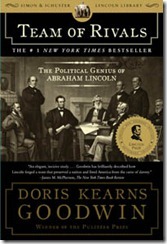
Historians over the last century have ranked Abraham Lincoln has one of the top two presidents in the history of the United States—most rank him first by a long shot. On the surface, the reason many cite is that his presidency coincided with the great turmoil and struggle in our history: the U.S. Civil War.
Doris Kearns Goodwin, author and historian extraordinaire, has penned a classic that could be classified not simply under “History > American History > Civil War,” but could stand as one of the finest books on leadership in print. Here is a description of the book from the Team of Rivals website:
Acclaimed historian Doris Kearns Goodwin illuminates Lincoln's political genius in this highly original work, as the one-term congressman and prairie lawyer rises from obscurity to prevail over three gifted rivals of national reputation to become president.
On May 18, 1860, William H. Seward, Salmon P. Chase, Edward Bates, and Abraham Lincoln waited in their hometowns for the results from the Republican National Convention in Chicago. When Lincoln emerged as the victor, his rivals were dismayed and angry.
Throughout the turbulent 1850s, each had energetically sought the presidency as the conflict over slavery was leading inexorably to secession and civil war. That Lincoln succeeded, Goodwin demonstrates, was the result of a character that had been forged by life experiences that raised him above his more privileged and accomplished rivals. He won because he possessed an extraordinary ability to put himself in the place of other men, to experience what they were feeling, to understand their motives and desires.
It was this capacity that enabled Lincoln as president to bring his disgruntled opponents together, create the most unusual cabinet in history, and marshal their talents to the task of preserving the Union and winning the war.
We view the long, horrifying struggle from the vantage of the White House as Lincoln copes with incompetent generals, hostile congressmen, and his raucous cabinet. He overcomes these obstacles by winning the respect of his former competitors, and in the case of Seward, finds a loyal and crucial friend to see him through.
This brilliant multiple biography is centered on Lincoln's mastery of men and how it shaped the most significant presidency in the nation's history.
According to the website, Steven Spielberg is making a movie based on this book, focusing on the last four months of Lincoln’s life and presidency.
I cannot recommend this book highly enough. Lincoln demonstrates how to reconcile and work with those who are not merely different from him in personality and ambition, but are indeed rivals—each having believed at one point they deserved the presidency more than he. The way he earned their respect and loyalty is something to behold.
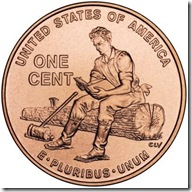 “Everywhere he went, Lincoln carried a book with him. He thumbed through page after page while his horse rested at the end of a long row of planting. Whenever he could escape work, he would like with his head against a tree and read. Though he acquired only a handful of volumes, they were seminal works of the English language. Reading the Bible and Shakespeare over and over implanted rhythms and poetry that would come to fruition in those works of his maturity that made Abraham Lincoln our only poet-president. With remarkable energy and tenacity he quarried the thoughts and ideas that he wanted to remember. ‘When he came across a passage that Struck him, ‘ his stepmother recalled, ‘he would write it down on boards if he had no paper,’ and ‘when the board would get too black he would shave it off with a drawing knife and go on again.’ Then once he obtained paper, he would rewrite it and keep it in a scrapbook so that it could be memorized. Word thus became precious to him, never, as with Seward, to be lightly or indiscriminately used.”
“Everywhere he went, Lincoln carried a book with him. He thumbed through page after page while his horse rested at the end of a long row of planting. Whenever he could escape work, he would like with his head against a tree and read. Though he acquired only a handful of volumes, they were seminal works of the English language. Reading the Bible and Shakespeare over and over implanted rhythms and poetry that would come to fruition in those works of his maturity that made Abraham Lincoln our only poet-president. With remarkable energy and tenacity he quarried the thoughts and ideas that he wanted to remember. ‘When he came across a passage that Struck him, ‘ his stepmother recalled, ‘he would write it down on boards if he had no paper,’ and ‘when the board would get too black he would shave it off with a drawing knife and go on again.’ Then once he obtained paper, he would rewrite it and keep it in a scrapbook so that it could be memorized. Word thus became precious to him, never, as with Seward, to be lightly or indiscriminately used.”  Doris Kearns Goodwin provided all Civil War lovers with a wonderful book entitled
Doris Kearns Goodwin provided all Civil War lovers with a wonderful book entitled 
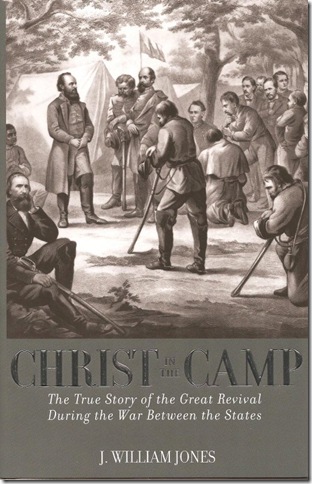 In a visit to
In a visit to 
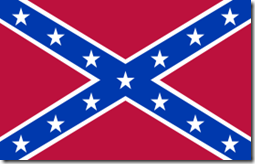
 The Confederate States of America has long held an interest for this ‘son of Virginia,’ ever since my second-grade teacher took us on a field trip to Appomattox. It’s infused in every Virginian the history of his native state. William C. Davis’ book on the last four months of the Confederacy is a marvelous book in giving the grim realities of how ‘the Cause’ flickered out.
The Confederate States of America has long held an interest for this ‘son of Virginia,’ ever since my second-grade teacher took us on a field trip to Appomattox. It’s infused in every Virginian the history of his native state. William C. Davis’ book on the last four months of the Confederacy is a marvelous book in giving the grim realities of how ‘the Cause’ flickered out. 



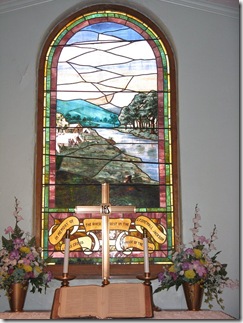 This is a window from the Fifth Avenue Presbyterian Church in Roanoke, VA. On it, it depicts the last words of Confederate General Thomas J. “Stonewall” Jackson: “Let us cross over the river, and rest under the shade of the tree”–spoken on May 10, 1863. Oh, one more thing: this is an African-American congregation! The descendants of this church sat under Jackson’s Sunday School class from 1855-1861 when it was illegal in Virginia for blacks to learn how to read and write, making Jackson a lawbreaker. They were so grateful for his work with them that these congregants chose never to forget the legacy of teaching Scripture. Take a
This is a window from the Fifth Avenue Presbyterian Church in Roanoke, VA. On it, it depicts the last words of Confederate General Thomas J. “Stonewall” Jackson: “Let us cross over the river, and rest under the shade of the tree”–spoken on May 10, 1863. Oh, one more thing: this is an African-American congregation! The descendants of this church sat under Jackson’s Sunday School class from 1855-1861 when it was illegal in Virginia for blacks to learn how to read and write, making Jackson a lawbreaker. They were so grateful for his work with them that these congregants chose never to forget the legacy of teaching Scripture. Take a 

